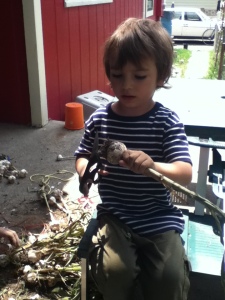
 Late in my pregnancy with Opal I decided I had to make a quilt for her. Of course, I did not know that she was a she. I had thought we might find out with number three, but John decided that he wanted to wait, and I respected that.
Late in my pregnancy with Opal I decided I had to make a quilt for her. Of course, I did not know that she was a she. I had thought we might find out with number three, but John decided that he wanted to wait, and I respected that. 

At the time I did not have so much peace with it. Part of me was becoming impatient to meet whoever had decided to join our family. But another part of me desperately hoped the baby was a girl. Not because I favored a girl over a third boy, but because I had always felt certain that there was a girl in our family, she just hadn’t arrived yet. And I longed to know her. I had already awoken from sleep life with her name lingering: Opal. I can’t imagine having discovered this name on my own. And, for the last two months of my pregnancy, I felt the need to surround myself with all things pink and lace and flowers. Finding myself at the fabric store, this is just what I ended up with.  Now that we know Opal, it is clear that she is not exactly sugar and spice and everything nice. I may have been more on the mark with every variation on fire and immovable mountains for fabric choices. But, half complete when I went into labor, and finished in fits and starts since then, she will be stuck with it. I think it will appeal to the small, Victorian pink, part of her that swoops in for a passing snuggle here and there.
Now that we know Opal, it is clear that she is not exactly sugar and spice and everything nice. I may have been more on the mark with every variation on fire and immovable mountains for fabric choices. But, half complete when I went into labor, and finished in fits and starts since then, she will be stuck with it. I think it will appeal to the small, Victorian pink, part of her that swoops in for a passing snuggle here and there.

My perfectionist days falling behind me, I enjoyed the process of stitching this quilt. (I will, at the very least have to look up some pointers on bindings before I make another one. This one is too flawed to be reproduced.) I do not say this with sentimentality but with matter-of-factness in regards to how our thoughts affect what we create: this is a quilt stitched with love and prayers. So, perhaps it is not so important, in the end, that it is a pink quilt for a not pink girl. I think it will do.





